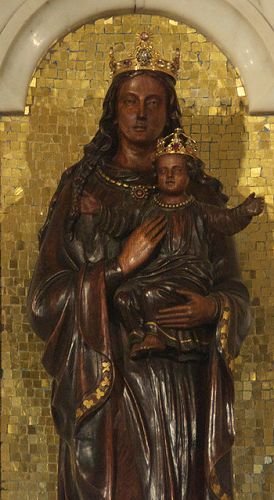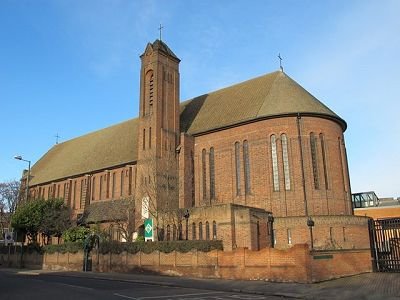London
The Anglican Statue
The Catholic Statue
Our Lady of Willesden,
the Black Virgin of Willesden
In Willesden, which is part of the London Borough of Brent in North West London. Similar to Walsingham in Norfolk, there are two sanctuaries dedicated to the Black Madonna of Willesden, a Catholic and an Anglican one. The Anglican St. Mary’s Church is at the original location: 110 Ellesmere Road, London NW10 1JS, It is open all day, every day, except Tuesday.
The Catholic Our Lady of Willesden Church is at: 1 Nicoll Rd, London NW10 9AX, 2.3 miles away, also open daily. The original Black Madonna was burnt on the banks of the Thames in Chelsea together with her famous sisters, the Madonnas of Walsingham, Worcester, and Ipswich in1538. She was carved of dark wood and silver plated, bearing a color "like ebony". The Catholic statue was carved in 1892 from an oak tree that stood on the site of the original church; it’s about 3 feet tall. The Anglican statue was carved by Catherini Stern in 1971 out of lime wood that has been ebonized; it’s about 3½ feet tall.
Willesden Anglican church
The Anglican shrine: The shrine’s website http://www.shrineofmary.org/shrine says: “The origins of devotion to Our Lady of Willesden are lost in depths of history; but there is evidence by the fifteenth century of a considerable pilgrimage tradition. (The shrine’s spring, which flows right under the church, was famous for producing cures, especially of eye problems. The first church stood on this site in A.D. 938, when it was a village outside of London.)
Pilgrimage medals even now are occasionally found. St Thomas More visited only two weeks before his arrest. It would have been quite an undertaking to visit, as Willesden was just woodland, and bandit country too. But for those living in and around London, it was the perfect way to make a day pilgrimage to an acknowledged Marian shrine without taking the much more arduous route to Walsingham, 120 miles to the north.”
After the Reformation, in order to deter any resurgence of worship of Our Lady of Willesden, the Vicar of the local parish of St Mary's had an enormous fine imposed upon him in perpetuity, for idolatry and superstition, should he dare to hold services at her church. Only at the beginning of the 20th century did a Vicar (Fr James Dixon) dare to throw off this antiquated shackle. Thankfully he was not punished and he set about reviving the shrine.
Father Dixon acquired a first image of Mother Mary, which was gilded and installed her in the place where the original Black Madonna had sat. That golden Madonna didn’t engender a lot of interest with the modern faithful; apparently they wanted a black one. They finally got their wish 70 years later, when a Black Madonna image was commissioned and Bishop Graham Leonard instituted an annual pilgrimages to her. With that, people began to flock to Willesden once again.
It wasn't until 1998 that the old spring was uncovered, dedicated, and the tradition of people collecting its holy water reintroduced. Several cures have already been attributed to it.¹
St Mary’s is a perfect example of Anglo-Catholicism, a style of Anglicanism that emphasizes its Catholic heritage and identity. It started in 1833 with the “Oxford Movement” that ushered in a “Catholic Revival”.
Willesden catholic church
The Catholic Shrine: Although the parish of Our Lady of Willesden lies 2.3 miles from the original shrine and lacks its holy well, it has been very successful in rousing masses of faithful. How? In 1892, a beautiful Black Madonna was carved from an oak tree that stood in the original church yard. Some say devotion to our Lady of Willesden began with an apparition of Mary to a parishioner in this oak tree and that the holy spring also began to flow at that point.² Since 1903, this ‘reincarnation’ (if you will) of the original Lady of Willesden goes through the streets in an annual procession on the second Sunday in May. There is also a torchlight procession the second Sunday in October. In 1954 she was crowned by Cardinal Bernard Griffin in Wembley Stadium, with 94,000 faithful from three dioceses in attendance!³ In a grand procession the Madonna was carried through the streets of London to the stadium and back to Willesden, 2.4 miles each way. Obviously many Catholics wanted to bear witness to the fact that Catholicism is still alive and well in Great Britain, even after 300 years of persecution and suppression.
Other Black Madonnas in London:
A copy of the Belgian Black Madonna Our Lady of Hal in Camden Town, 165 Arlington Rd., NW1 7EX
Copies of the Spanish Black Madonna of Montserrat and the Mexican Our Lady of Guadalupe, in Our Lady of the Immaculate Conception Catholic Church, 114 Mount St., Westminster, in the heart of London, W1K 3AH
Footnotes:
1. According to a conversation between Hillary Ratnasabapathy and the vicar of St. Mary’s in 2016.
2. See: a you tube video called: Our Lady of Willesden the Narional Shrine Beautifully done, although the end is sadly divisive.
3. See this newsletter article of the parish.
For further reading see: Matthew J. Milliner’s: “The Duelling Virgins of London”





